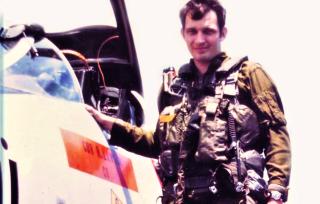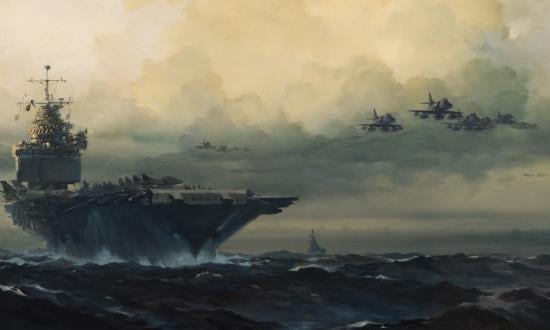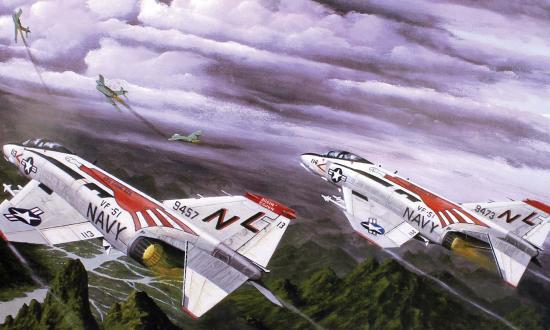Combat as an attack pilot is preceded by years of training and absorbing books on lessons learned before finally joining a squadron with experienced pilots to guide you. If you are lucky, the squadron has consistently adapted to counter the enemy’s tactics. It has developed rules of engagement and tactics that give you an advantage. Combat is the ultimate competition, where the environment is changing constantly. It is a place where luck becomes a necessity.
For the Ghost Riders of Attack Squadron 164, the attack mission was a deadly game of numbers. Squadron and wing leaders, along with other assets, provided guidance and protection, but in the end, especially in Vietnam, you had to commit to the battle by pointing your nose to the earth, diving, and holding a straight and predictable path. All while the enemy was firing hundreds of antiaircraft artillery (AAA) rounds, desperately trying to blow you apart.
The enemy would put up as many AAA rounds as he could along your path as you rolled in. On heavily defended targets, there could be so many rounds bursting between you and your target it was difficult to see the earth. You did not have to be a rocket scientist to figure out if you did it often enough, you would take a hit and, eventually, worse. While having Lady Luck on your shoulder was highly desirable, it did not trump the numbers.
To mitigate the risk against heavily defended targets, the rule was to make only one run, releasing all weapons. However, there were exceptions to the rule, especially when friendly troops were trying to hold off the enemy from overrunning their positions. Those troops’ lives depended on your ability to destroy as many enemy forces as possible. The most effective way to accomplish this was one weapon at a time, adjusting for better accuracy after each run and stretching out your time over the target to break up any attack. Sometimes you would make a dummy run, not releasing ordnance, to deter their next attack.
Then there were times when you were trying to destroy a high-value, heavily camouflaged target found by a forward air controller (FAC). The Air Force FACs flew small propeller-driven aircraft, and normally a crew was assigned the same area so they could quickly recognize any changes in the terrain. They flew low and slow, with only marking rockets for ordnance. The enemy AAA gunners were smart and generally did not engage the FACs, since they knew it would bring a great deal of ordnance down on them. The enemy gunners’ job was to protect their troops and supplies, so shooting at a FAC would ensure that the very protection they hoped to supply would be put at great risk. But sometimes they could not resist what they viewed as an easy kill!
There was one such day when Lady Luck was on my shoulder. I was part of a flight of four Skyhawks and assigned to a Covey FAC in northern South Vietnam along the invasion route. As we were briefed by the FAC on the way to the target, it was clear that the only way we were going to find this very clever AAA crew was by drawing their fire. The terrain below us was wall-to-wall jungle canopy, with no sign of human presence. The FAC put down a “Willie Pete” smoke marker where he believed the AAA site existed.
The formation spread out in a large circle at 10,000 feet, so everyone could observe all the Skyhawks, to watch over our wingmen and let them know if they were being engaged by AAA or missiles. But most important, we could watch the roll in and dive run to look for the telltale cotton ball cloud rising up from the jungle camouflage. This small white ball was smoke rising from the muzzles and would mark the aim point for an attack.
The AAA site would only begin firing when it had a good fire-control solution, which a diving aircraft provides. So, normally, we would limit our runs, as the enemy had an advantage. Each dive was an opportunity to destroy a Ghost Rider. At the same time, multiple runs increased the likelihood we could find the cotton ball and destroy the enemy. The flight lead calls the shots and knows the risk, so he has to be the bait to get the fight going! When lead rolled in, the AAA site opened up, and then we knew we were dealing with a ZSU-23 system.
The ZSU-23 has four 23-mm cannon barrels firing 3,200–4,000 rounds per minute. That is a lot of bullets coming up at you. However, we still did not have a visual on the hidden ZSU. Eventually, we would locate it for a short time, until it quit firing as a Skyhawk pulled off. But with the sea of green jungle below, there was no feature in the landscape we could use as a reference as we maneuvered for our roll-in point. As each aircraft dove, the ZSU began firing, but it took time to scan the jungle to find the muzzle smoke coming up through the camouflage and jungle.
On my second dive, I located the cotton ball late in my dive and did not have enough altitude left to make corrections. I released and pulled off, deciding to switch from a pure manual run to the CP-741. This small computer allowed me to set the gunsight to zero mills in the dive and just hold the pipper on the target to stabilize. Then press and hold the pickle and, smoothly, with wings level, pull Gs to recover from the dive. The CP-741 would release the bomb when it calculated it could be “tossed” into the target. This system required the pilot to dial in the target altitude and the difference in barometric pressure from the standard. It represented the beginning of precision bombing, and like all computers, depended on the inputs being correct. But it provided the flexibility to quickly adjust the aim point without having to continue diving into the target until the predetermined release altitude. This had the benefit of giving the ZSU gunner less time to get a kill.
As I came around for my third attack, I was able to find the cotton ball and quickly placed my pipper on the ZSU position. I continued the dive, and closing the range, I concentrated on the target to improve accuracy. I wanted this target gone and was willing to take the risk to get it done. In other words, I let my fangs grow. About that time, in my peripheral vision, I noticed multiple thin smoke trails around my canopy!
The ZSU ammo contains a mixture of rounds, with about 15 percent being tracers, which have a small flare in the base of the round. This allows the gunners to see where their bullet stream is going and adjust as needed. At night, they create a bright stream like a huge hose of death rising up to meet you. In the daytime, the flare is not bright enough to see from the cockpit, but the gunners are looking directly at the base of the cannon shell and can see the stream.
My first thought was “What the heck is that?” Milliseconds later, it rang home that rounds were streaming past my Skyhawk on all sides! If I did not get out of this dive immediately, they would start pounding into the machine and me. Pipper on the target, I pressed the bomb pickle, pulled hard, and felt the thump of a Mk 82 being ejected off the wing rack. At the same time, I ducked my head down and closed my eyes. No sense watching my own demise. I aggressively pulled my nose up, keeping my wings level to get the nose up quickly. A few seconds later, my nose was above the horizon. I broke hard to starboard then rolled port, standing on my wing looking down at the target. It takes about eight to ten seconds for an 500-pound bomb to reach the earth, and this maneuver is used to be in a position for spotting the hit.
In deep jungle, with a mechanical delay fuze, the first thing observable is the compression wave from bomb detonation. Slightly after that comes the true reward of a large red fireball blasting from the target, which means a secondary explosion of ammo and fuel. A bullseye! The FAC was elated, and I was ecstatic.
However, I knew the bullseye was the CP-741 doing everything it was supposed to do, and I had almost gotten nailed. It was one of those times I felt both exultation and disquiet.
There were other events during that 1972 combat cruise and the years afterward. Nevertheless, this was the first time life shoved it in my face that training, talent, experience, and technology cannot always save you from a bad outcome.
I understood the FAC wanted that AAA site destroyed, because that ZSU had killed another FAC. When providing close air support for the troops, the FAC was essential. Therefore, if one of them needed us to get something done, we took on the risk. One day we might need him to get us out of the same jungle, and we knew he would be there for us, taking the risk, hoping Lady Luck was on his shoulder.
The extreme courage of the Air Force and Navy rescue and FAC crews was demonstrated constantly. There were times when a pilot on the ground would order them to go home, knowing he could not tolerate their sacrifice for his life. These were extremely sad events.
Editor’s Note: This is an edited excerpt from the book 1972 Ghost Rider Memories (self-published, Amazon, 2021).








